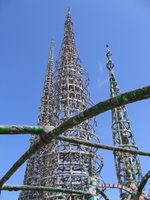
Trying to be the good student that I always wanted to have in my own classes, I took the class description of Botanical Illustration in the adult education schedule as a requirement and dutifully brought with me to the first class meeting a flower to draw. I had to really comb my yard, as it is not planted with pretty things, but I managed to find a perfectly opened camellia--a single-petaled bloom called Yuletide.
But what I really find interesting about this shrub, that completely screens my studio window, are the fat glossy seed pods that form after the flowers have withered, and they were part of my composition. The second week I drew a sunset colored hibiscus from the yard, but by the third week of class I had a twig of some eucalyptus variety. It wasn't the common tall tree with the slender leaves. This one came with seed pods that looked like jumbo martini olives. I loved drawing it; I did it twice, taking a second view of the dark leaves and the almost purple pods.
I was through with flowers.
While nearly everyone else in class dipped their brushes in their watercolors to capture garden roses, lilies and morning glories, or native wildflowers and sages, I started to concentrate on detritus. I looked down at my feet and found a carpet of interesting stuff; there were pods, seeds, and leaves starting to lose living color and take on a broad range of sublter shades. In addition, a good wind might bring down branches and bark in curious shapes.
I began to walk my neighborhood, collecting acorns and scattered oak leaves from trees that anchored either end of my block. And eucalyptus! The two markets where I regularly shop have parking lots planted with eucalyptus, so that whenever I open my car door just within reach is a selection of pretty leaves. It was hard to resist tossing just a few gems into my shopping bag.
Since I was working in colored pencil, I was not as swift as many of my fellow students who were working in watercolors. But I enjoy the zen of building color layer upon layer. My teacher, Chris Chapman, advised me to underpaint--just as an artist working in oils might--when I was contemplating how to capture the colors in a curled piece of eucalyptus bark. I also discovered a few others who were using colored pencils, and in time we all migrated to the same part of the classroom. I found these women a source of both support and inspiration, as well as information, such as what color is that, and where did you find that pencil sharpener?
I drew various native shrubs--branches of California Red Bud and Fremontia, leaves from my Babcock peach, a Ginko tree at the Huntington Gardens and some grape leaves from the Getty Villa--but no matter what diverts me, I am continually fascinated by eucalyptus and coastal live oaks. Throughout the year each yields a particular seasonal beauty.
Just about the time I think I could be content drawing only the eucalyptus' infinite variety, I will glimpse a hint of a Coastal Live Oak. Underneath an oak the fallen leaves form a cushy tan carpet, but if you look closely at an individiual leaf you might be surprised to find that the underside is a sienna brown while the top side is pale, almost flesh colored, and--even more amazing--iridescent. In the spring the new sprigs are pale lavender before they emerge as dark green leaves and the tiny arorns are positively chartreuse. Now in October the acorns have fattened up and their mossy hue is changing to mahogany.
By now I have a plentiful supply of both eucalyptus and oak sheddings. My studio has a brown paper bag filled with oak twigs with pale green lichen, and leaves and acorns are currenlty strewn across my drawing table. An Indian basket in the dining room is heaped with ochre eucalyptus leaves and drying pods. Charlie tells me I don't need a broom to clean up, I need a rake. But look closely, see the beauty in the details.
California's iconic oak is as much a symbol of the state as golden rolling hills and blue waves. The natives have endured many assaults over the years. They've been cut for furniture, floors and firewood; cleared for vineyards and housing tracts. Nowadays they are threatened by Sudden Oak Death disease and the seedlings are crowded by invasive grasses.
Eucalyptus, likewise, is under assault. At the end of the 19th century the Australian native was imported in an effort to produce a fast-growing hardwood for railroad ties and housing lumber. The wood turned out to be useless for both purposes, but its sheddings of leaves and bark--the very things I find so beautiful--choked out native plants and habitats. By 1973 there were grumblings that these exotic water-suckers should never have been planted in the first place, and the Oakland-Berkeley fire of 1991 was the final straw. The swaths of eucalyptus in the canyons were veritable roman candles which rapidly spread the fires which ultimately destoryed 3,500 homes. Since then many Northern Californians have mounted organized programs to eradicate the foreigners from their midst and replace them with native species.
The two trees strike at the root of our equally volatile political issue of what to do about the immigrants and natives in our state and nationwide. Some would oust the outsiders without a moment to look at them as individuals, while others try to find a tolerant balance for all who live here. If I could offer any lessons I've learned from looking intently at the details, it is that the closer I look the more beauty I see.
I've come to realize my drawings are really the story of California--the story of immigrants and natives.



























